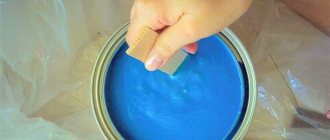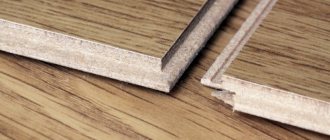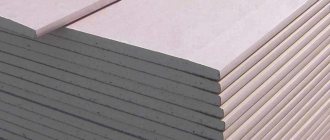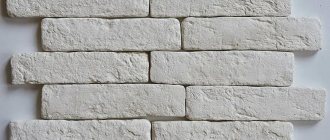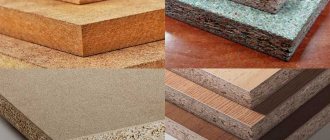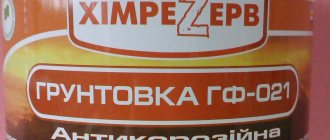The remarkable construction properties of gypsum have been known since ancient times. In addition to statues and monuments, ancient architects often used this material in the construction of buildings, engineering and military structures, and widely used it in finishing work.
Today, gypsum remains the same popular mineral in construction. The well-known plasterboard is made from it, which is necessary for interior decoration.
But not everyone knows that this material has a serious competitor - gypsum fiber (GVL), which in its technical characteristics significantly exceeds plasterboard.
Two big differences
That's what they'll say in Odessa. And they will be absolutely right, since all the advantages of gypsum plasterboard over drywall are visible to the naked eye.
Drywall is a layer of compressed gypsum, covered on both sides with construction paper (cardboard).
GVL slabs are not covered with cardboard. The fibers in them are produced from paper waste, which is thoroughly crushed and then mixed with gypsum and special additives.
The mixture thus prepared is then pressed. The result is not just compacted gypsum, as in dry plaster, but a material reliably reinforced with fiber.
Material composition and production method
Just by the name of the material you can determine what drywall is made of. The main components that make up drywall are gypsum and cardboard.
Gypsum is a natural soft mineral. It is obtained from sedimentary rocks. Gypsum is dried and fired at a low temperature of 150–180 ° C, followed by grinding. Since building gypsum is a natural material, it is safe and non-radioactive.
The sheet filler may contain small quantities of PVA glue, starch, chemical soap, etc. The dry components of the mixture give the board the desired structure, and the soap foams the filler, making it lighter.
The gypsum mixture is poured between two layers of high-density cardboard, the longitudinal edges of which are folded to form an end of the desired shape. In this way, a long GCR strip is obtained. The next stage of production is cutting the material into sheets of a certain length. These sheets are then dried and stored.
This is how simple drywall is made. The production of other types of building materials, moisture-resistant and fire-resistant, is somewhat different.
Both layers of moisture-resistant drywall are impregnated with special additives. They include antiseptics and waterproof mixtures. These additives protect the material from mold and mildew, allowing it to be used in damp areas, such as the bathroom.
The fire-resistant sheet is reinforced with a special fiberglass mesh. In the event of a fire, the cardboard covering is sintered and the sheet retains its shape.
Moisture-resistant includes the properties of both moisture-resistant and fire-resistant sheets. The production method is similar to other types.
All additives used in production must comply with GOST standards and undergo mandatory certification and safety testing.
So, if gypsum plasterboard is made from high-quality materials, then the composition and the manufacturing process of drywall guarantee its environmental friendliness and do not pose a danger to human health.
Standard sizes
According to GOST R 51829-2001:
Thickness: 10, 12.5, 15, 18 and 20 mm.
Length: 1500, 2000, 2500, 2700, 3000. 3600 mm is often on sale. (Not included in the list approved by the resolution of the State Construction Committee of the Russian Federation)
Width: 500, 1000 and 1200 mm.
The most popular are gypsum fiber board sheets with a thickness of 10 and 12 mm, a length of 2500 mm and a width of 1200 mm.
There are also non-standard slabs, both small and large format. So, for flooring it is best to use sheets more than two centimeters thick.
Classification and technical characteristics
GLV slabs are divided into standard ( GLV ) and moisture-resistant ( GVLV ).
The former are well suited for interior decoration of industrial and residential premises, in which there is a normal temperature regime and fairly dry air.
Moisture-resistant sheets are treated with a hydrophobic solution, thanks to which they can be effectively used in all wet rooms (kitchen, toilet, bathroom), as well as in attics, basements, garages and many other construction sites.
Both standard and moisture-resistant gypsum boards have a rectangular shape.
They can be with direct ( PC )
And folded ( FC ) edges.
Marking
The marking is applied to the back of each gypsum fiber sheet and looks like this:
- The sheet type (GVL/GVLV) is indicated first.
- The group of type and manufacturing accuracy (A/B) is indicated
- Edge type (see above). PC or FC.
- Dimensions.
- Standard
Transcript example
GVLV-B-FK-3000 × 1000 x 15 TU 5742-004-03515377-97.
Moisture-resistant gypsum fiber sheet, group B with seam edge. Size 3000 × 1000 mm. Thickness 15 mm.
Is drywall in an apartment harmful to human health?
- The key element of this sought-after building material is gypsum. In fact, it is an absolutely natural, natural material that was previously burned at a high temperature and then ground. It is safe for people and the environment and has zero radioactivity.
- In small quantities, PVA and starch can be found in drywall. As you understand, both of these elements are absolutely harmless.
- The hardened gypsum core is pressed between two cardboard sheets. So the wrapping of our material is not dangerous.
However, the “hand of the market” dictates its conditions, and in pursuit of large profits, many manufacturers try to save on consumables or bypass some expensive production cycles. And in this case, the answer to the question whether drywall is harmful or not should be addressed to the manufacturer.
May 15, 2021 polrostov 172
Share this post
- Related Posts
- Maximum Taxable Base for Calculating Personal Income Tax in 2021
- Social Security Found a Fake Certificate
- Workplaces with Harmful Working Conditions Class 3 B Dow
- What an Accident, Power Outage in March in the Center of Moscow
Tensile strength
| Sheet thickness S, mm | Weight , kg/m2 | Bending strength , MPa |
| from 10 to 12.5 | (1.05-1.25) S | 5,5 |
| from 12.5 to 15 | 5 | |
| from 15 to 18 | 4,8 | |
| from 18 to 20 | 4,5 |
Characteristics
| Characteristic | Meaning |
| Humidity, % | up to 1.5 |
| Density, kg/m3 | up to 1250 |
| Surface water absorption, kg/m2 h | up to 1 |
| Thermal conductivity, W/(m °C) | 0,22-0,36 |
| Heat absorption coefficient, W/(m °C) | up to 6.2 |
| Vapor permeation resistance, m2 h Pa/mg | 0,12 |
| Brinell hardness, MPa | from 20 |
| Fire-technical characteristics . SNiP 21-01-97 | GVL, GVLV |
| Flammability group according to GOST 30244-94 | G1 |
| Flammability group according to GOST 30402-96 | IN 1 |
| Smoke generation group according to GOST 12.1.044-89 | D1 |
| Toxicity group according to GOST 12.1.044-89 | T1 |
With a plus sign
In addition to high strength, GVL sheets have many other positive characteristics.
- Environmentally friendly, repeatedly tested and proven.
- High viscosity. You can drive nails into gypsum plasterboards and screw in screws without dowels. They will be held just as firmly and reliably in this material as in wood. It will not be possible to do the same in drywall; you will end up with an ordinary hole.
- GVL sheets do not crumble, which is very convenient when processing them. No special tools are required, leaving little waste.
- Like plasterboard, fiber has a low thermal conductivity coefficient, which allows this material to be used as a reliable thermal insulator for rooms.
- GVL also has good sound insulation. Although here a lot depends on the thickness of the slab.
- Gypsum fiber can be used as a fire-fighting material to protect buildings, communications and various building structures.
- GVL sheets are quite light and therefore do not create additional loads on the load-bearing elements. Due to their light weight, they are easy to carry and install even for one person.
- The bending strength of gypsum fiber is twice that of plasterboard. Therefore, GVL sheets are successfully used in complex structures and intricate interiors: suspended ceilings, arches, decorative ceilings, etc.
- The high frost resistance of GVL has been repeatedly tested in practice. Sheets of this material can withstand repeated freezing and thawing. Thanks to this property, they can be used in unheated structures, for example, country houses.
- If the room is damp, then gypsum fiber can dry it by absorbing excess moisture. Conversely, in a very dry room, gypsum fiber board sheets humidify the air well.
Gvl Harm to Health
There are also several other types of drywall: moisture- and fire-resistant. They have a slightly different composition because they contain special additives. The core of moisture-resistant plasterboard contains hydrophobic additives, and the gypsum core of the fire-resistant material is reinforced with glass fibers, contains crystallized water and fire-resistant elements. Each of the additives and impregnations used undergoes the strictest quality and safety control.
- First, the tape is glued, which is necessary to compensate for changes in the material due to temperature changes. It needs to be fixed along all the walls of the room in the place where the gypsum fiber boards will be laid. If you have not leveled the floor or insulated it, then treat it with a deep-penetrating primer.
- Next, we fix the sheets to the finished base using glue and self-tapping screws (they need to be screwed in every 35-40 cm around the perimeter of the gypsum fiber 2 mm inward). Make sure that the sheets are laid evenly; the seams should not extend less than 20 cm.
- The surface is being prepared. The old coating is removed. True, not all masters advise this, considering it an unnecessary waste of time and effort.
- Using a level, plumb line and pencil, mark the wall. For vertical racks take a ceiling profile. The guides are mounted in areas adjacent to the floor and ceiling.
Frame method
- The brackets are attached to the racks with self-tapping screws, and the profiles are aligned using a folding cutter. The profiles are attached to the ceiling with dowels in increments of 60 cm or slightly less.
- GVL are installed from bottom to top or top to bottom with a small gap between them.
In the gypsum fiber boards cut according to the markings, cutouts are prepared for switches and sockets. The height of the GVL should provide gaps in the lower part of approximately 8-12 mm. They will be closed in sections after the main slabs are installed. For greater reliability, the plates are tightened with self-tapping screws.
You may like => Certificate of Completed Work Warranty Repair
In order to make sure that drywall is harmless, you first need to find out what this material is made of. Sometimes on the Internet you can find simply crazy statements about the enormous harm of this convenient type of finishing. “Drywall is harmful to health,” write people who are little familiar with this building material.
- The acidity pH level is the same as that of the skin. Therefore, this lining is comfortable for the body and almost never causes allergic reactions .
- Drywall is resistant to fire and the risk of fire in a building finished with plasterboard is minimal.
Application
Due to their versatility and excellent qualities, gypsum fiber boards are widely used in construction and renovation of premises. Most often they cover walls, window and door openings, and ceilings. This is done not only to hide communications, but also for fire protection purposes.
GVL sheets are well suited for internal partitions. Due to the high strength of the material, they reliably hold doors and hanging parts.
Moisture-resistant slabs will serve as an excellent substrate for flooring for wooden and reinforced concrete floors. On top of such a structure you can lay tiles, parquet, linoleum, laminate, and other finishing materials.
In the photo above (left side) is the so-called dry screed (expanded clay + GVL)
When using GVL, the flooring process is significantly accelerated compared to “wet” methods, since you do not need to wait for the surface to completely dry for several days, or even weeks.
Gypsum fiber sheet (GVL) - pros and cons
The technical characteristics of GVL allow their use in a wide range of construction and finishing works. The most common application is cladding walls, ceilings, door and window openings, both for the purpose of leveling and hiding communications, and for fire protection.
As for the number of layers of gypsum fiber sheets, in most cases one is enough, but you should remember that if you are going to lay a second layer, then the sheets should lie perpendicular to the components of the previous ones, displacing the seams of adjacent rows, they are also attached with glue and self-tapping screws. But to make it more convenient, you can use special sheets that glue the slabs together during installation. Their installation will be easier, since they have a smaller thickness and a seam that will help place one sheet on top of another.
Don't skimp on quality
When purchasing gypsum fiber board sheets, we advise you to follow simple but effective rules. Buy products only from well-known manufacturers who have proven themselves well in the Russian market.
Even if their product is somewhat more expensive, we advise you not to waste time on trifles. Low quality gypsum fiber will cause you a lot of trouble and will not allow you to make repairs at a high level. You will most likely have to pay twice.
Pay attention to the markings of each sheet, since outwardly they are no different from ordinary plates.
What is the difference between GKL and GVL?
Let's look at regular gypsum plasterboard, what it is, and how it differs from gypsum plasterboard. Drywall consists of gypsum with additives and cardboard lining. Depending on the area of application, the material has different composition and properties. For visual distinction, products are painted and marked. There are the following types of drywall:
- GKL.
- GKLV.
- GKLO.
- GKLVO.
GKL can be wall or ceiling. GKLO is a fire-resistant material that contains reinforcing additives. Sheets are used only in dry rooms. The color of the cardboard marking is red.
GKLV is a moisture-resistant material that is impregnated with hydrophobic and antibacterial compounds. Water-repellent compounds have been added to the gypsum layer, so it is used in rooms with high humidity. The cardboard is green and the markings are blue.
GKLVO sheets are moisture and fire resistant. The product combines the properties of GKLO and GKLV, adding hydrophobic components.
The color of the sheets is green, the markings are red Source srbu.ru
GVL has a density of 1250 kg/mᶟ. The panels are made from gypsum, reinforced cellulose and additives. GVL Knauf differs from drywall:
- strength;
- frost resistance;
- absorption of excess moisture;
- creates a healthy microclimate.
See also: Catalog of companies that specialize in finishing materials and related work.

